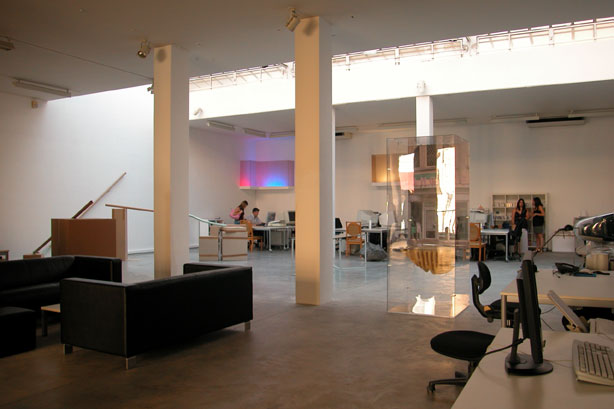
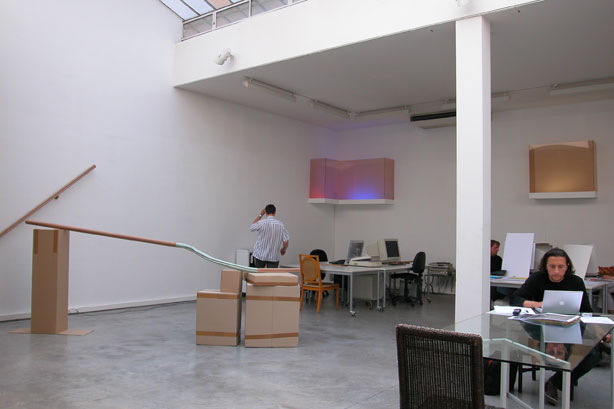
Vues de l'exposition / Installation views
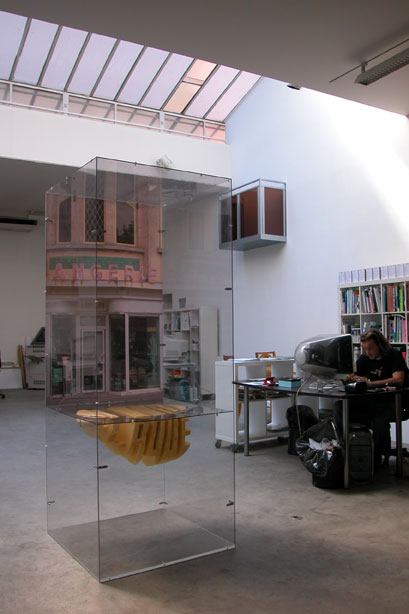
Angerie de Caroline Boucher (vitrine dans l'espace) & Patricia de Ingrid Luche (le balcon au mur à droite) / Angerie by Caroline Boucher (showcase in space) & Patricia by Ingrid Luche (the balcony on the wall on the right)
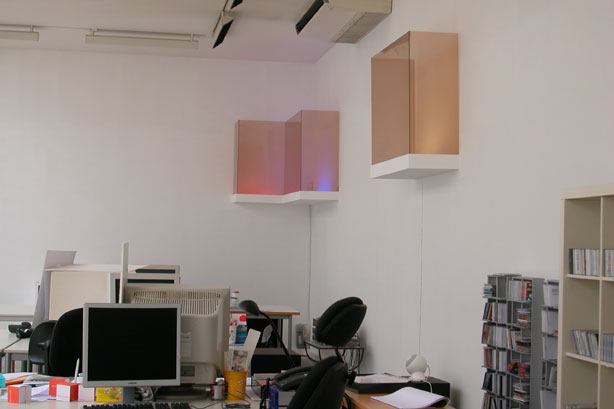
All Day And All Of The Night - 2005
(le balcon d'angle / the corner balcony)
Bois peint, néons clignotants, Altuglas / Wood, flickering neon lights, Altuglas
105 x 171 x 106 cm
Collection publique / Public collection
Blanc
(le balcon de droite / the balcony on the right)
Bois, tube fluo blanc, Altuglas / Wood, fluorescent white light, Altuglas
105 x 118 x 40 cm
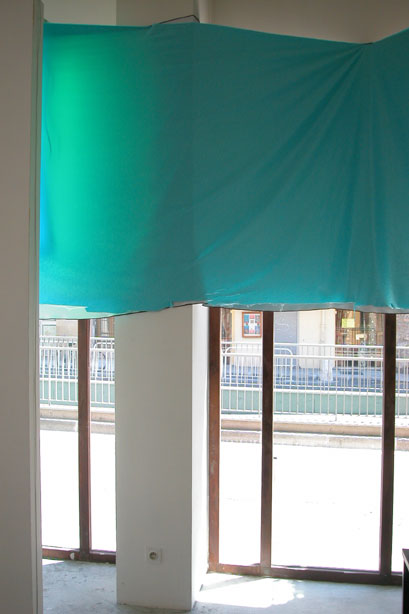
Nuit et jour - 2005
Collaboration avec/with Caroline Boucher
Tissus, tubes flurescents / Fabric, fluorescent colored light
C. 15 m, dimension variable / C. 15 m, size variable

Vue de l'installation : Nuit et jour & Pop up the volume de Caroline Boucher (Sculpture en carton) / Installation view : Nuit et jour & Pop up the volume by Caroline Boucher (Cardboard sculpture)
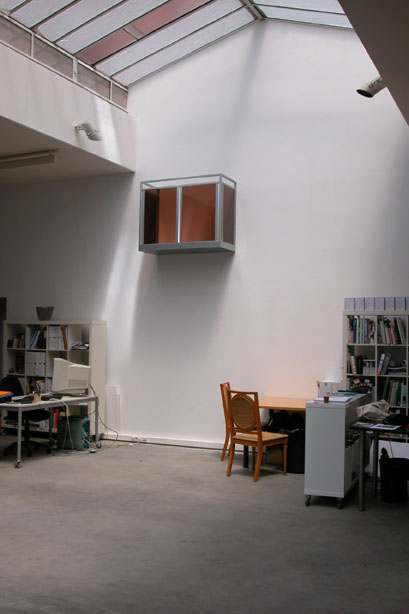
Patricia - 2004
Acier peint, bois, Altuglas / Painted steel, wood, Altuglas
95 x 120 x 50,5 cm
Le cadre du Dojo se prête aux préoccupations de Caroline Boucher et Ingrid Luche : espace au sol supérieur à 200 m2, vitrine, rez-de-chaussée, verrière, lieu de travail habité de ses employés, bureau mobile, l’architecture permet d’envisager une véritable collaboration comme pour Nuit et jour, la vitrine du Dojo.
Caroline Boucher invite Ingrid Luche en 2001 à entretenir une correspondance pour l’écriture du texte d’un catalogue personnel « Le circuit de l’économe » aux Éditions de la Villa Saint Clair à Sète. Cet échange verbalise leur approche de l’espace et un imaginaire commun dans la construction rotative de leur pensée.
Les œuvres de Caroline Boucher appellent l’équilibre du regard de l’autre, s’appuient sur une organisation dimensionnelle et situationnelle de l’objet. Constructions autonomes, ses sculptures ont une entité idéelle, puisent leur économie de vie dans la perspective dimensionnelle de leur présentation, dessinent le lieu qui les expose sous leurs angles de champs. Dans ses expositions récentes, Caroline se distancie des « objets » usuels ou fabriqués et épure ses sculptures. Elle utilise le carton seul, ses découpes formant une colonne, un escalier, un piédestal… Un emballage détourné de ses fonctions initiales induirait-il la forme de l’objet qu’il protège ? « Le retour des blisters vivants » ou le téléformage des objets du commerce s’autogénère à la mesure des espaces de stockage dont nous disposons. L’usage du polycarbonate vient à point manifester la transparence des murs qui nous conditionnent : dans son œuvre Angerie, la photographie d’une façade de Boulangerie ne laisse entrevoir qu’une partie de son enseigne. Enserrée dans un volume de polycarbonate qui s’apparente à une vitrine, une flaque en mousse de polyuréthane extrudé prolonge l’image, forme éponyme, s’étend sur et sous les deux surfaces transparentes de l’étage unique dont est doté le volume principal. Le paysage extérieur traverse l’œuvre et l’œuvre intègre le paysage, cadrage.
Les deux nouveaux balcons d’Ingrid Luche proposés pour Le Dojo traversent ce double jeu au travers de leurs manques et de leurs artifices et retourne sur elle-même la dimension corporelle de nos habitations.
All Day And All Of The Night, et Blanc, introduisent la transparence d’une façade vitrée dans l’espace intérieur, reflets de jeux d’enseignes et éclairages de rue tout en un. Installés à deux mètres de hauteur, les garde-corps initiaux disparaissent, laissant les vitres d’Altuglas fumé préciser leurs contours. Leurs supports sont en bois peint en blanc mat. Les deux suspensions partagent une façade commune.
All Day And All Of The Night loge dans un angle et le souligne. Des néons clignotants semblent scander une devanture de restaurant, un grill ou un bar de nuit comme une enseigne lumineuse l’annonce dans la rue. Dans le cadre du Dojo, les lumières s’unissent au fond blanc du mur que le balcon épouse. La transparence colorée de l’Altuglas modifie ces signaux, au plafond l’éclairage violacé de jour et montre les deux halos rouge et bleu à la tombée de la nuit.
Blanc, prolongeant l’un des murs du premier balcon, esquisse une façade absente dont n’émerge ici que la lueur blanche d’un tube fluo. Éclairage d’intérieur filtré par un store invisible non totalement descendu ou levée du jour, la lumière blanche se fond aux variations solaires offertes par la verrière et des éclairages d’appoint des bureaux individuels, ceux des écrans d’ordinateur principalement.
The setting of the Dojo lends itself to the concerns of Caroline Boucher and Ingrid Luche: floor space greater than 200 m2, showcase, ground floor, glass roof, workplace inhabited by its employees, mobile office, architecture allows us to envision a real collaboration as for Nuit et jour, the Dojo showcase.
Caroline Boucher invited Ingrid Luche in 2001 to maintain a correspondence for the writing of the text of a personal publication Le circuit de l’économe (The Peeler Circuit) published by Villa Saint Clair in Sète. This exchange verbalizes their approach to space and a common imaginary in the rotating construction of their thought.
Caroline Boucher’s works call for balance in the gaze of the other, are based on a dimensional and situational organization of the object. Autonomous constructions, his sculptures have an ideal entity, draw their economy of life from the dimensional perspective of their presentation, draw the place which exposes them from their field angles. In her recent exhibitions, Caroline distances herself from usual or manufactured “objects” and refine her sculptures. She uses cardboard alone, its cutouts forming a column, a staircase, a pedestal ... Would packaging diverted from its initial functions induce the shape of the object it protects? «The return of living blisters» or the teleforming of commercial objects is self-generated according to the storage spaces available to us. The use of polycarbonate comes at the right time to show the transparency of the walls that condition us: in his work Angerie, the photograph of a bakery facade only reveals part of its sign.
Enclosed in a polycarbonate volume that resembles a display case, a puddle of extruded polyurethane foam extends the image, eponymous form, extends over and under the two transparent surfaces of the single floor with which the main volume is provided. The exterior landscape crosses the work and the work integrates the landscape. Framing.
Ingrid Luche’s two new balconies proposed for Le Dojo cross this double game through their shortcomings and their artifices and turn on itself the bodily dimension of our homes. All Day And All Of The Night, and Blanc, introduce the transparency of a glass facade into the interior space, reflections of signs and street lighting all in one. Installed two meters high, the original guardrails disappear, leaving the smoked Altuglas windows to define their contours. Their supports are made of wood painted in matt white. The two pendant lights share a common facade.
All Day And All Of The Night fits into an angle and emphasizes it. Flashing neon lights seem to ring out a restaurant front, grill or nightclub like an illuminated sign in the street. As part of the Dojo, the lights unite with the white background of the wall that the balcony hugs. The colored transparency of the Altuglas modifies these signals, on the ceiling the purplish daylighting redraws two red and blue halos at nightfall.
Blanc, extending one of the walls of the first balcony, outlines an absent facade from which only the white glow of a fluorescent tube emerges here. Interior lighting filtered by an invisible blind not fully lowered or sunrise, the white light blends in with the solar variations offered by the glass roof and the auxiliary lighting of individual offices, mainly computer screens.